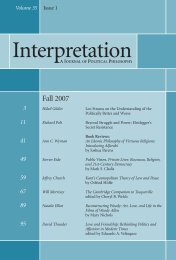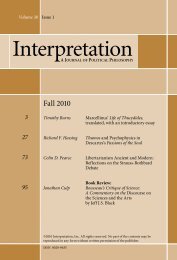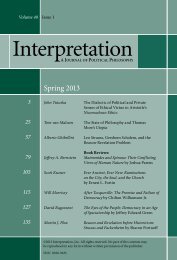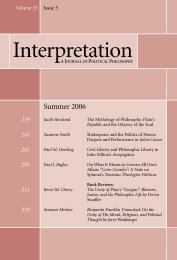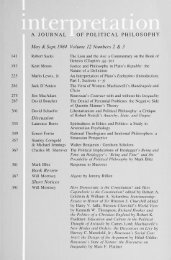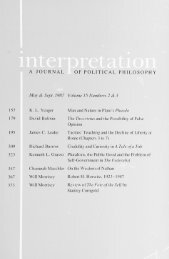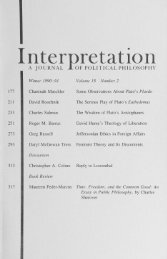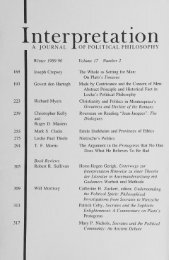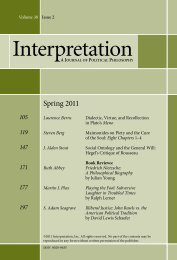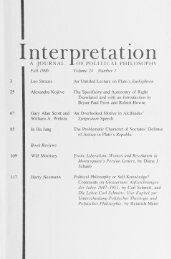Spring 2010 - Interpretation
Spring 2010 - Interpretation
Spring 2010 - Interpretation
Create successful ePaper yourself
Turn your PDF publications into a flip-book with our unique Google optimized e-Paper software.
Book Review: Aristotle’s Dialogue with Socrates 3 1 9<br />
The beautiful is first introduced as the telos of ethical virtue<br />
(NE 1115b12-13; Burger, 49). It stands in contradistinction to phronesis,<br />
whose telos is the good (NE 1140b20-21; Burger, 71). As Burger puts it, “the<br />
beautiful proves to be, together with the just, the independent principles that<br />
show up in the manifold of particular virtues and withstand their absorption<br />
into phronesis: the beautiful and the just supply the force of resistance<br />
against the Socratic move that would deny the autonomy of the sphere of<br />
ethical virtue” (49). The beautiful is “independent” because it is desired for its<br />
own sake; in contrast, phronesis, which looks to the good, appears to be only<br />
of instrumental value.<br />
In Plato’s Phaedrus, Socrates offers an account that describes<br />
the object of each individual’s eros as the god that represents the ideal or<br />
perfection of the individual’s nature. Aristotle’s examination of the manifold<br />
of virtues in books 3-4 suggests the same thing. “The beautiful,” therefore,<br />
appears to be the projection of and desire for perfection and completion.<br />
Ethical virtue, however, is limited in its origins and its scope.<br />
After all, it is identified as the excellence of the desiring part of the soul. As<br />
Burger puts it, “someone who looks to the beautiful as his end and chooses<br />
his action because of itself does not understand his character formation as<br />
a molding of passions tied to the body” (202). This would seem to suggest<br />
that the beautiful sought by the passions and named by the ethical virtues is<br />
not the true beautiful, the truly independent, self-sufficient one sought for its<br />
own sake and for nothing else (199-200). True eros for the beautiful must be<br />
the goal solely of mind. The harnessing of (ethical) virtue to phronesis ensures<br />
that the eros or drive of the passions will be beneficial to the individual by<br />
placing the passions under the command and guide of the good, but it does<br />
not satisfy the longing for perfection or the ideal. Sophia, therefore, as the<br />
excellence of (a part of) mind, not the passions, steps in to replace ethical<br />
virtue and looks like it will be able to succeed where ethical virtue could not.<br />
But, the introduction of sophia heralds a new division. In the moment when<br />
phronesis reins in and unites the desires and reason, sophia divides mind into<br />
practical reason and theoretical reason.<br />
For a moment in book 6, Aristotle appears to unite the two.<br />
Offering the analogy of health and medicine, he declares that “theoretical<br />
reason produces happiness, not as medicine produces health, but as health<br />
itself makes a person healthy” (NE 1144a3-4). Happiness is the province of



